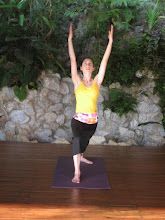I spend a lot of time in the kitchen during Passover because I refuse to eat matzah at every meal. And to keep life interesting, I try a couple new recipes each year.
The last couple of posts have been focused on what I DON'T eat during Passover - bread, rice, legumes, corn, etc - so you are probably wondering what I DO eat. The simple answer is: lots of vegetables! I gravitate toward starchy root vegetables like potatoes and carrots to make up for the lack of grains in my diet. Last night I roasted Yukon Gold potatoes with cherry tomatoes, onions and mushrooms with a pinch of oregano. Yummy! My next project: homemade "Terra Chips" - thinly sliced beets and parsnips coated in olive oil and baked till crisp.
The one grain, actually a pseudo-grain, that I eat is quinoa. Quinoa is a member of different botanical family entirely - it's actually related to spinach. Quinoa was deemed Kosher for Passover several years ago by a rabbi in Israel because it is unrelated to any of the five forbidden grains (wheat, oats, barley, spelt and rye) which can be made into dough with leavening potential (aka. chometz). It is distinct enough from any of the other foods that fall into the category of kiniyot (foods that are close enough in culinary properties so easily substituted for the forbidden grains). And since quinoa primarily grows in the Andes mountains of South America away from other cereal grains, there is no possibility of comingling.
Just prior to the holiday, I had gotten into the habit of starting the day with a homemade muffin (gluten-free corn). So I decided to make some sort of Passover-style muffin. I bought some "Kosher for Passover" baking powder at the Kosher grocery store. How can such an overt leavening agent be "Kosher for Passover? Well, baking powder is basically a combination of an acid (sodium pyrophosphate) and an alkaline (sodium bicarbonate, which is baking soda) substance mixed with a small amount of starch (typically corn starch). When the powder is mixed with liquid, the acid and alkaline react to give off CO2, the gas that makes quick breads rise. For Passover, the corn starch is replaced with potato starch. While some folks would reject baking powder altogether during the holiday because it makes things rise, I prefer to take the product's label at face value. This year (every year, I make a determination of how strict I will observe the holiday) I have decided to use baking powder and baking soda in my holiday recipes. I'd rather prepare my own baked goods using healthy, natural ingredients than buy products from a Kosher for Passover bakery (which relies on GMO and/or hydrogenated cottonseed oil). I further rationalize my decision to use baking powder by defining "leavened" in a Biblical way - risen by fermentation (a natural, biological process). Baking powder did not exist in the time of Moses so the prohibition against its use is a modern rabbinical one. Very observant folks make desserts with beaten egg whites to give them a light, airy texture. This strategy is also technially a means of leavening - the addition of air to the batter using physical means. So rather than engaging elbow grease, I dabble in a little kitchen chemistry.
Passover Banana Quinoa Muffins
Makes 12 small muffins
1/4 cup olive oil
1/4 cup sugar
2 eggs (preferably organic, cage-free)
2 ripe bananas, mashed (about 1 1/2 cups)
1/2 cup plain yogurt
3/4 cups matzah cake meal
1/2 cup quinoa flakes
1/2 tsp cinnamon
pinch of salt
1/2 tsp baking soda
Preheat oven to 350 degrees and line muffin tin with paper liners.
Whisk together oil, sugar and eggs. Stir in mashed bananas and yogurt. In a separate bowl, combine matzah cake meal, quinoa flakes, cinnamon, salt and baking soda. Add dry to wet ingredients. Stir to combine and spoon batter into muffin cups. Bake for 22-24 minutes.
Allow muffins to cool before trying to remove from paper muffins cups (if you don't, they muffins will stick to the paper).
Note that this recipe calls for baking soda (an alkaline substnace) because I include yogurt which is acidic.
Cauliflower Kugel
Serves 6 - 8
1 medium head of cauliflower
2 Tablespoons olive oil
2 spring onions, white parts sliced
2 eggs
1 tsp salt
1/4 tsp black pepper
2 Tb potato starch
4 Tb almond meal (finely ground almonds)
Preheat oven to 350 degrees and oil a 9" square baking dish.
Cut cauliflower into florets and steam until fork tender. Drain.
While cauliflower is steaming, saute onions in olive oil.
In a food processor, puree 2/3 of the steamed cauliflower with sauteed onions, eggs, salt, pepper, potato starch and 2 Tablespoons of almond meal. Combine puree with reserved cauliflower florets. Transfer mixture to baking dish. Sprinkle with remaining almond meal and bake kugel for 50 minutes to an hour, till firm and golden brown on top.
Subscribe to:
Post Comments (Atom)





No comments:
Post a Comment